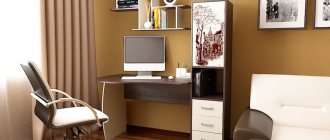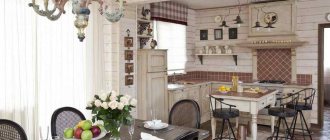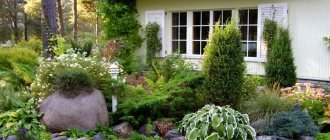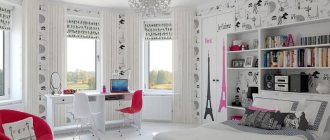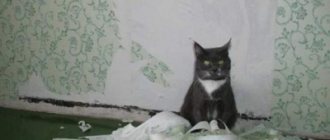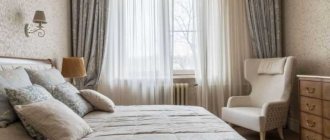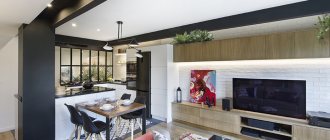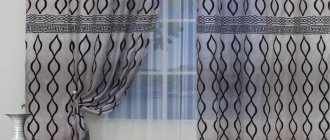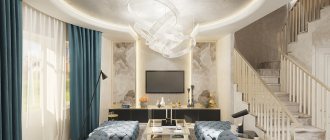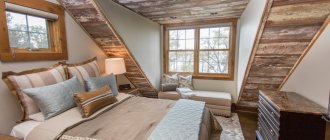What to pay attention to when registering
Organizing book storage is a forward-thinking solution that helps not only to systematize book accumulations, but also at the same time make the interior more original. The following techniques will help you solve the problem:
- Choose the right room. It is worth abandoning the idea of installing a library in the kitchen with its changes in temperature and humidity. It is also not recommended to install bookshelves in dark, unventilated utility rooms (pantry, basement).
In the recreation area Source www.klasbagger.se
- Do not disturb the style of the room. Bookcases, shelves and racks are selected in a suitable color palette and style. If the interior is decorated in a classic style, choose furniture with a touch of antiquity: solid wood shelves or closed cabinets with glazed doors. Modern interiors are more democratic, and allow the use of both classic furniture (in case of mixing styles) and modern designs on a metal frame.
Full use of space Source st.hzcdn.com
- Take care of old publications. Such specimens require special care. The best choice would be a glass cabinet that protects books from dust.
In the attic Source image.bluprin.com
- Think about safety. Hanging shelves lined with books must be securely fastened; the same applies to all floor structures. The condition is especially important in a home where there are children.
Bookshelves above the sofa Source design-homes.ru
- Take care of comfort. A home library is more than just cabinets and shelves. Armchairs, a sofa and a coffee table will allow you to create a reading area, and using the library will become much more comfortable.
Kingdom of books Source roomester.ru
- Consider convenience. A convenient tool for searching for books will be to systematize them according to some principle. The collection can be divided into genres or areas of knowledge, arranged alphabetically, and separated children's publications from adult ones. If there are a lot of books, a catalogue, electronic or paper, will help.
With notes of ethno-style Source www.thehousethata-mbuilt.com
- Don't forget about replenishment. Having appeared, the library grows from year to year, and this must be taken into account. It’s good if there is free space in reserve on the shelves or in the closet, and you know where, if necessary, you can put an additional rack.
Library in the bedroom Source www.smh.com.au
See also: Catalog of projects of wooden houses with a mansard roof.
Classic interior
A home library in a classic style is furnished with wooden furniture with elements of artistic carving, or strict, laconic models with regular, clear forms in a traditional format are selected. You can also add a soft chair with quilted textile upholstery, but preferably made of leather or high-quality leatherette. The classic direction is complemented by parquet flooring or carpet. The finishing touches will be paintings in carved frames, bas-reliefs, antique floor clocks with a pendulum, beautiful vases and exquisite figurines.
If there are a lot of books
If the library is really large, the optimal solution for its organization would be to allocate a separate room. A room entirely devoted to books is rare; more often it is adapted for an office. Private libraries began to appear en masse about two centuries ago; Since then, the tradition has been preserved of decorating a room dedicated to printed publications in the style of Victorian interiors.
Interior with fireplace Source st.hzcdn.com
The classical library plays an important role in the home. This is a great place to concentrate, work, and re-read your favorite volume in silence. A respectable environment will be a good backdrop for communicating with guests or business partners.
Everything for comfortable reading Source i.pinimg.com
A home library, the interior of which is made in a traditional style, is a stylish and comfortable room with a special atmosphere. Large windows and high light ceilings decorated with stucco give it a particularly impressive look. For the walls, a color is selected from a calm, warm palette, for example, gray, coffee, olive. Parquet or high-quality laminate is used as flooring; the windows are decorated with heavy curtains that harmonize with carpets and furniture upholstery.
Dark wood interior Source i.pinimg.com
For a traditional interior, choose tall classic cabinets made of solid wood, comfortable and spacious. You can use both open (racks) and closed cabinets with hinged doors and drawers.
In a bright interior Source dekormyhome.ru
See also: Catalog of companies that specialize in glazing and installation of roof windows.
There are no clear criteria for the number and height of bookshelves. Since books can have very different formats, it is useful when one cabinet has shelves of different heights. Library cabinets are decorated with carvings, original fittings, and gilding.
Shelves are never superfluous Source st.hzcdn.com
To make the most of the usable space, bookcases are made to order. Thus, narrow corner cabinets fit organically into the space between the window and the entrance opening. For high shelves, a wooden ladder must be made that matches the color of the rest of the furniture.
Wardrobe with ladder Source i.pinimg.com
The convenience of a library is determined not only by the capacity of the shelves, but also by how comfortable it will be to spend time reading books here. Therefore, in a room given over to a library, you need armchairs, a sofa, and a coffee table. If the room serves as an office, a work (writing) table, chairs, bureau or chest of drawers are added.
Library in the office Source decoor.net
Cleaning books
Creating a decent interior for your home library is one thing; but keeping it clean is another thing and requires taking care of your books.
Think about how much dust will accumulate on those book shelves. Regular cleaning will prevent you from sneezing while reading, and will also protect you from pests that might want to feast on your literary treasures.
Remove the books and wipe down the shelves with a soft cloth and a little polish. Wipe books with a clean microfiber cloth. Or use a vacuum cleaner - it's that easy!
Seating in the living room
When it is not possible to allocate a whole room for books, the democratic approach wins, and books find a place in different rooms. This solution is suitable for both classic and modern interiors, and most often the choice falls on the living room, as the most spacious room in the house (apartment). To date, the following methods of placing books in the living room are actively used:
- Modular (sectional) furniture. The option fits into most modern interiors, but when choosing, you need to pay attention to such design features as the depth of the shelves. Preference should be given to models designed to store books in one row; It’s convenient if the shelves are height adjustable. Another important parameter is the ratio of the length and thickness of the shelves. The longer and thinner the structure, the more likely it will not support the weight of books.
In the interior of the living room Source i.pinimg.com
Restoration of old cabinets
Furniture that was made in Soviet times is of very high quality. Many homes have cabinets that have been used for decades and remain intact. True, their appearance does not always fit into modern interiors. But this is not a reason to replace them with new furniture; it is enough to restore them, change the external design, and the result is an exclusive and stylish thing. Doing this is not so difficult and such work is often done at home.
You can change the color of the cabinet in three stages:
- stripping;
- primer;
- painting.
First, the layer of old varnish and paint is erased with sandpaper. Next, if necessary, the existing defects are filled with wood putty. After this, the surface of the cabinet is primed with a special compound. Finally, the furniture is painted in any chosen shades. After painting, the restored cabinet can be left as is, or decorative elements can be added. For example, if you cut out patterns or other details from paper, glue them to the surface with PVA glue and cover them with transparent varnish, you will get designer furniture made using the decoupage technique. For a country style, you can decorate the surface of the cabinet with craquelure technology, painting it with special paints and varnishes to create an antique effect. Sometimes textile lace or wallpaper is glued onto furniture, which looks very unusual and sophisticated. There are many stylistic decorative details available on the market that you can use to create a stylish, modern design for outdated cabinets.
Library in the corridor, on the loggia
One of the non-trivial ways to arrange a library is to arrange it in an unusual place; The corridor is ideally suited for this role. Usually it has an elongated shape and looks empty. One of the long walls is overlooked due to its inconvenient location.
A neat bookcase will expand the poor functionality of the corridor, and, very likely, will become a feature of the interior. A sufficient shelf width will be 25-30 cm (the size of an average book); At the same time, it is important not to forget about comfort - the width of the passage should not be less than 90 cm.
At the exit Source st.hzcdn.com
It's easy to make a boring space around the stairs stylish and useful. You can use open or closed shelves, or a combination of both. More interesting options for a mini library at home are obtained when the book storage is designed simultaneously with the staircase. Then you will surprise guests with unusual built-in (integrated) shelves, made in the same style as the surrounding space.
Under the stairs Source i1.wp.com
If the staircase structure is open, then it is easy to organize a reading corner under it. One comfortable chair and proper lighting are enough to create a place for privacy with your favorite book. Complete comfort will be provided by a soft blanket and a pair of pillows.
A balcony or loggia is converted into a library according to the same principle: bookshelves are hung or a cabinet is installed, an armchair is brought. Sometimes a full-fledged office is arranged in such a room; in both cases it is important to take care of insulation.
On the balcony Source ic.pics.livejournal.com
Book storage
Of course, the storage space for your home library will depend on how many books you have (or how many you plan to purchase). If you have a large collection, then floor-to-ceiling bookshelves are the best option. Maybe even built-in ones if your budget allows it.
For smaller gatherings, you can install free-standing shelving, or just a shelving unit.
Library as a decorative element
The interior design of a modern library does not use developments characteristic of the classical tradition. It is not following the norms that is valued here, but experimentation. For this reason, in modern living rooms and offices there are racks and shelves of the most non-standard configurations, many of which are made personally by the owners.
Such designs inevitably turn into the interior highlight of the room. The only significant drawback of most of these shelves is their limited capacity.
Creative solution Source st.hzcdn.com
There is another way to turn books into decorative elements. To do this, they are sorted by the color of the covers, and it doesn’t matter if they don’t match perfectly - the shelves look bright and conceptual. The problem with this method is that in the average library the distribution of cover colors is very uneven, and a beautiful effect may not be achieved. If this is your case, wrap the covers in paper of your desired color. To get a stylish result, you can choose three or four shades for wrapping, and sign the names or stick on stickers.
All the colors of the rainbow Source novaonidc.vn
Important nuances
To ensure that your bookcase is positioned at the required distance from the floor, use metal table or furniture legs. You may have to shorten them - a hacksaw will help you with this. At the same time, do not forget to wear a protective rubber tip so as not to spoil the floor surface. The rack will not be able to tip over with its front end forward if you take care to attach it to the ceiling using two long screws and dowels. In this case, you will need to install a spacer so that the screws between the shelf and the ceiling do not lift the rack.
Materials like chipboard and MDF are made from sawdust. However, while synthetic resins are usually used as a binder during the manufacture of chipboards, MDF particles are usually held together using lignin and paraffin. It follows from this that MDF is a more environmentally friendly material, but with a lower density than chipboard.
Another piece of advice is that the required shelving configuration can also be made to order by selecting from several aspen options the shelf sizes that suit you, the number of open and closed sections, and the type of doors (hinged or sliding). However, this will seriously affect the final cost of your product.
Someone may ask: what should I do with newspapers? One option would be to make a newspaper rack with your own hands. The newspaper stand consists of two identical plywood parts. In order for the longitudinal sides to fit together, they are usually sawed off at a miter angle, maintaining an angle of 60°, after which they begin to create curly cutouts that will serve as a place for newspapers. For this purpose, both parts are combined and the locations of future holes are marked. The holes are then drilled with a 40 mm hole saw, while the distance between the centers of the holes should be 100 mm. After this is done, mark the jumper lines and cut out all the excess using a jigsaw. At the end, all the parts are glued together, the top edge is filed at an angle of 45 degrees and the corresponding lid is glued.
Tags:Furniture
Decorating a toilet library
Every person, at least once in his life, spent alone time in the bathroom with a book in his hands. There are a number of people who need a library in such an unexpected place.
The toilet is the smallest room in the entire apartment or house. Book storage space is limited, so you need to plan carefully. Suitable furniture:
- console shelf: it can accommodate several small books and magazines, made of metal, glass, plastic or wood;
- shelf-module (hanging): this is a kind of mini-rack for books that is attached to a special rod;
- flat floor bookcase: for true bibliophiles, you can make a larger library; the appearance of such furniture is similar to a shoebox with hinged doors (you can make an open version);
- niche: Many bathrooms have niches, this is a great way to save space and display books on shelves that can be customized in size and design.
Related article: How to install a chimney for a gas water heater
If the bathroom is combined with a bathtub and the room has sufficient area, then zoning can be done with a narrow shelving from floor to ceiling.
In this room you don’t have to skimp on the decoration. You can emphasize the presence of the library in such an unexpected place using:
- colorful tiles;
- wallpaper that imitates printed pages of books and newspapers.
Home library - interior solutions
Library. For many, the phrase “home library” is associated with the luxurious mansions of wealthy aristocrats. However, you can organize a beautiful and convenient library at home.
With built-in shelves or inexpensive bookcases, you can turn almost any room in the house into a library. Recently, more and more often you can find rooms that combine a library and a dining room. Your home office will also feel more cozy if you add bookshelves to it. If you like to read in the bedroom and there is a free corner there, arrange a small library there. Not enough space in your home? Place a row of shelves right in the hallway. Whichever option you choose, any well-organized reading room can be proudly called a library.
#1. How to Create Home Libraries
To create a home library, you need three main elements: space, furniture and books. You don’t need any special room for this – just free up one of the rooms in your house or apartment. To create a truly beautiful and comfortable library interior, you will have to work with the space.
- First, it’s worth determining what the purpose of creating a library is. Decide for yourself whether you want to have a purely functional library, or one that also gives aesthetic pleasure.
- Search the Internet for examples of architectural and interior design. Many websites and blogs offer photo archives of the best home libraries.
- Make sure that the floor of the room you choose to house the library is strong enough to support heavy shelves loaded with books. Pay attention to the humidity in the room. If dampness accumulates in the room and mold develops on the walls, your collection may be irreversibly damaged.
- Choose a single style to decorate your library. Many designers adhere to the styles of Renaissance, Spanish and Victorian architecture when decorating libraries.
- Experiment with design elements. Don't be afraid to combine and mix architectural details, even if you plan to follow a single design style.
- Decide what type of shelves you want to install in your library. Built-in shelving gives the room an elegant look and does not “steal” space, but installing them will require the help of a professional. Bookcases and shelves can be chosen from a wide variety of colors, materials and sizes, but they require a lot of space to arrange them. Hanging shelves can be placed in any way that suits you, but they need to be installed with particular care and precision.
- Try to make optimal use of library space. Regardless of the chosen architectural style, it is necessary to properly organize the space of your home library so that it meets your needs. If your collection is constantly growing, you should purchase higher shelves. High shelves will allow you to use the space of the room more efficiently and give the library a solid look.
- Design techniques such as preliminary sketches and using sample materials can help you better visualize the end result of your design. Careful advance planning will help you avoid unpleasant mistakes and save money.
#2. Tips and tricks
- Remember that your home library is for you. Stereotypes about what a home library should be like need to be cast aside. You are creating a library that will become your personal temple of knowledge and mental relaxation.
- You can contact a professional architect or interior designer. A specialist will help simplify the translation of your plans into reality.
- If living conditions allow, it is worth setting aside a separate room with smooth walls for the library. This is more convenient than combining a library with a room for another purpose.
- While a fireplace certainly adds a classic touch to a room, it is worth taking safety precautions when placing a fire source in a library, as it can pose a potential threat to your book collection.
#3. Examples of home libraries
Let's start with a few examples of traditionally styled libraries. The designers of this and the next two libraries appear to have followed the styles of the works of Albert Hadley and Billy Baldwin. Dark wood, well-positioned shelves, comfortable royal-style chairs, fresh flowers, curtains with tassels - all these details give the library a very rich look.
in the photo: home library in a brown office
Pay attention to the interesting design of the upper part of the room.
in the photo: classic home library in the office
To make the most of the space, install tall cabinets and shelves.
in the photo: original home library shelves
Use a ladder to access the upper shelves. And of course, if you wish, you can place a TV in the library. From a technical point of view, both books and television are sources of information, right?
in the photo: stairs in the library
Bright, cozy, modern - this room perfectly combines a library and a living room.
in the photo: library in the living room
But this is a good combination of a library and a dining room. At first glance, it may seem that the owners of the room are careless in handling the books, since they are all placed with their spines facing the wall. However, this photo was taken by a professional photographer, and the books were positioned this way deliberately to give the photo a distinctive style.
in the photo: library in the dining room
In this library-dining room, the table is equally suitable for a gala dinner with friends or a business conference with colleagues.
in the photo: library in the dining room
Here's a great library and home office combination.
in the photo: home library and office
Here every centimeter of space is occupied by shelves.
in the photo: library in the hall
In this multifunctional room, each of the many bookshelves looks very appropriate.
in the photo: bookshelves in the living room
A library may contain other interesting objects besides books.
in the photo: interior of the collector's library
A long bookcase and a small staircase transform the hallway into a library.
in the photo: library in the hallway
Below we will present a few more pictures with library design samples.
Literature of artistic content
The most voluminous section of the library, where most beginning book lovers get lost, because they dream of embracing the immensity. Let's start with the basics - any fiction is divided into prose and poetry. A classical library cannot consist of works of the same type; this impoverishes the book collection and turns its perception into “hard work.” Therefore, be sure to choose works of both prose and poetry.
Further, you can create a library according to different principles.
Formation of an art library by historical periods
In fiction, it is customary to distinguish 7 main historical periods:
- Literature of antiquity.
- Middle Ages.
- Renaissance.
- Enlightenment.
- XIX century.
- XX century
- Since the middle of the 20th century - postmodernism.
If everything is more or less clear with the choice of authors who wrote in a certain century, then the initial periods require explanation.
The classics of the ancient world are considered to be authors before the 3rd century AD of the peoples of Greece, Rome, China, India, Iran, Judea (Israel), and Egypt. The most famous authors and works:
- Homer "Iliad", "Odyssey".
- Poetry of Sappho and Anacreon.
- Tragic works - Euripides, Sophocles, Aeschylus.
- Comedies of Aristophanes.
- Philosophical works of Socrates, Plato, Aristotle.
- Authors of the Roman era - Plutarch, Cicero, Horace, Seneca.
World classics of the Middle Ages (IV-XV centuries):
- Christian Gospels.
- "Tristan and Isolde".
- Chrétien de Troyes "Lancelot, or Knight of the Cart"
- Guillaume de Lorris "The Romance of the Rose".
- Spencer "The Faerie Queene".
- Benoit de Saint-Maur "The Romance of Troy".
- "A Novel about the Count of Poitiers."
- "Robert the Devil."
- Polen Paris "Novel about the Fox".
The best works and authors of the Renaissance (XV-XVI centuries):
- Dante.
- Petrarch.
- Boccaccio.
- Shakespeare.
- Lope de Vega.
- Thomas More.
- "Gargantua and Pantagruel" by Rabelais.
- "Don Quixote" by Cervantes.
- Michel Montaigne.
- Thomas More.
- Leonardo da Vinci.
- Edmund Spencer.
- Martin Luther.
- "In Praise of Folly" by Erasmus of Rotterdam.
- "Ship of Fools" by Sebastian Brunt.
Times of Enlightenment:
- Swift "Gulliver's Travels".
- Defoe "Robinson Crusoe".
- Jean-Jacques Rousseau "The New Heloise".
- Choderlos de Laclos.
- Diderot "Encyclopedia".
- Voltaire.
- Lafontaine.
- Moliere.
- Comedies by Fonvizin.
- Fables of Sumarokov.
- Odes of Derzhavin and Lomonosov.
- Goethe.
- Schiller.
- Karamzin “Letters of a Russian Traveler”, “Poor Liza”.
- Thomas Gray.
- Richardson.
By “modern times” the literary heritage is becoming richer and more interesting.
| Classics of the 19th century | XX century | Postmodernism |
| Byron, O. de Balzac, W. Blake, Baudelaire, Heine, Hoffmann, V. Hugo, C. Dickens, A. Daudet, A. Dumas, E. Zola, F. Cooper, J. London, P. Merimee, Guy de Maupassant, Edgar Poe, A. Rimbaud, R. Rolland, J. Sand, J. Stael, Stendhal, M. Twain, W. Thackeray, O. Wilde, A. France, Chateaubriand, Schelling. K. Batyushkov, Gogol, Goncharov, Griboyedov, F. Dostoevsky, Zhukovsky, Lermontov, Pushkin, L. N. Tolstoy, I. S. Turgenev, F. Tyutchev, A. P. Chekhov | Ch. Aitmatov, V. Astafiev, A. Akhmatova, A. Bely, Yu. Bondarev, Bulgakov, V. Bykov, B. Vasiliev, V. Vysotsky, R. Gamzatov, M. Gorky, D. Granin, V. Grossman, E. Evtushenko, M. Zoshchenko, F. Iskander, E. Kazakevich, B. Okudzhava, V. Pikul, V. Rasputin, Yu. Semenov, A. Solzhenitsyn, A. Tvardovsky. P. Valery, W. Wolfe, J. Joyce, F. Kafka, T. Mann, M. Proust, F. Fitzgerald, W. Faulkner, E. Hemingway, T. Eliot. | J. Barth, Samuel Beckett, William Burroughs, C. Vonnegut, W. Gibson, J. DeLillo, H. Murakami, Salman Rushdie, J. Heller, W. Eco, M. Atwood, Hawks, F. Dick, H. Cortazar , J. Fowles, T. Pynchon, M. Danilevsky, V. Erofeev, E. Limonov, V. Pelevin, Sasha Sokolov. |
A luxurious opportunity for book lovers to acquire the best of world fiction in collected works. Three magnificent libraries have been collected and published by professional publishing houses:
- Russian classics – 141 volumes.
- World literature – 200 tons.
- Foreign classics in 589 volumes.
All the best in world and domestic literature, worthy of the richest library. A combination of image design and respectable content.
Novels by women
Novels about love, written most often by women, reflecting their inner world of psychological and sensory experiences. Books for the female half of the family to relax. There is no need to collect a lot of modern “reading” here, but the books of the best love classics will decorate any book collection.
Famous authors: Nora Roberts, Joanna Lindsay, Jane Austen, Kathleen Woodiwiss, Charlotte Brontë.
Fantasy classics
Every family is sure to have its own fans of the fantasy genre. Its elements arose a long time ago, but the fantasy of ancient centuries is practically not in demand. Therefore, a modern library is formed by authors no older than the 19th century.
The best creators of science fiction of the 20th century and today: G. Wells, A. Belyaev, A. Tolstoy, V. Obruchev, A. Tarkovsky, the Strugatsky brothers, N. Perumov, M. Semyonova, S. Lukyanenko, R. Howard, J. Tolkien, C. Lewis, R. Bradbury, F. Dick, A. Asimov, R. Heinlein. Ursula le Guinn, R. Zelazny, P. Anderson, M. Moorcock, R. Sheckley, T. Pratchett, A. Sapkowski. The splendor of imagination, combined with the excellent literary language of the authors, allows us, without a doubt, to add them to the list of “worthy” books for any home library.
Literary and artistic magazines
The best works of artistic poetry and prose often begin their “journey” to the reader from the pages of “thick” magazines. This has been the case since the 18th century and remains so to this day. It’s a great success to find a selection of old magazines and arrange them to be bound under a common cover, putting the first editions of the best works of the 20th century on the shelf of your home library.
The undisputed leaders in demand have always been the magazines “New World”, “Friendship of Peoples”, “Znamya”, “Foreign Literature”, “Our Contemporary”, “Youth”. The publications “Don”, “Zvezda”, “Neva”, “October”, “Ural” and others always found their readers. Even today, the rich literary heritage that passed through the pages of these magazines has not been fully published.
Other ways to create a home art library
For lovers of literature and geography “all in one,” the library can be formed according to the regional principle – according to the alphabet of continents and countries. Within each country, highlight poetry, prose and children's literature. To create a list of authors for each country, you can contact specialists at an online bookstore, or choose literature yourself, focusing on the indication from which language the book was translated. Today you can collect a library of works of art from more than 140 countries.
The “backbone” of the best library will certainly be the world’s “golden fund” of novels : V. Hugo, Dumas father and son, Stendhal, Balzac, Zola, Flaubert, Maupassant, Proust, R. Rolland, Cervantes, W. Scott, C. Dickens , W. Thackeray, T. Dreiser, J. Updike, T. Wolfe, J. Steinbeck, E. Hemingway, Goethe, G. Mann, E. M. Remarque, Feuchtwanger.
Among Russian authors, it is impossible to imagine a home collection of books without the works of A. Pushkin, M. Lermontov, N. Gogol, F. Dostoevsky, L. Tolstoy, I. Turgenev, I. Bunin, A. Fadeev, M. Bulgakov, M. Sholokhov , M. Gorky, B. Pasternak, A. Solzhenitsyn and a number of other writers.
For polyglots, you can collect literature in any languages known in the family. In addition to Russian, this can be a section of English, French, German or any other literature in the original language. The combination of multilingual books in one library encourages family members to study previously unknown languages and amazes the guests with the intellectual abilities of the owners.
All the best for children
Any home library is unthinkable without children's literature. Even if your children are well over 20, you can always invite your grandchildren and great-grandchildren to your library. The children's section of a self-respecting home library must have fairy tales, poems, works of a prosaic nature (short stories, novels, novels) and fairy tales (the fantasy genre).
The best writers for children by genre
- Fairy tales: Russian folk tales, tales of the native people, C. Perrault, the Brothers Grimm, A. Pushkin, A. Lindgren, G. H. Andersen, L. Tolstoy, K. Ushinsky, D. Mamin-Sibiryak, A. Volkov, M. Uspensky and many others. Today it is possible to collect a magnificent library of folk tales from more than 150 countries and nationalities of the world.
- Poems: A. Barto, S. Marshak, K. Chukovsky, G. Oster, B. Zakhoder and others.
- Stories: N. Nosov, V. Dragunsky.
- Stories of various topics: A. Gaidar, L. Kassil, M. Twain, V. Kataev, N. Aseev, L. Carroll, N. Nosov, L. Lagin.
- Novels: J. Verne, V. Medvedev, A. Rybakov, K. Bulychev, D. Defoe, J. Rowling, R. Stevenson, L. Boussenard, M. Twain, A. Green, W. Scott, F. Cooper.
- Fiction: K. Bulychev, V. Krapivin.
Issues of visual design of a home library
An ideal library should look stylish, orderly and expensive, working not only to serve the family’s hobbies and artistic interests, but also to create its image before contemporaries and descendants. Therefore, no matter what book you choose on the topic, try to create an overall feeling of beauty and harmony.
Collections of works decorated in the same style, books in exclusive binding, and books of equal size on one shelf give the library a magnificent appearance. It is convenient to highlight the literature of one country, one genre, subject, language, etc. with a color scheme. For some owners of book wealth, it is especially pleasant to have their favorite authors printed in the best bindings, which will immediately distinguish them from the general variety of books.
On massive mahogany shelves it is better to place rare historical publications in classic leather binding in brown shades. Modern bright shelves will create harmony with large format publications in light colors. It is not at all necessary that the library coincide with the general design style in the house. Anything the owner likes can be created here - from a classic dark office to a hall with impressive columns, high-tech metal or retro style. A stylized library will make a great impression on others. Fantasies are possible on any theme, from an ancient cave to a medieval castle or a spaceship.
A properly compiled catalog and a clear arrangement of books on shelves and racks will help you navigate the ocean of books.
Bookplates and owner's binding
The famous book collections of the past of great families are distinguished by another feature - the presence of a bookplate, a book sign identifying the owner of the book. It was placed on the left side of the flyleaf. In especially noble families, the superex libris was placed on the cover or spine. The sign included the name and surname of the owner, as well as a figurative sign indicating the profession or characteristics of the library itself.
Such “marking” of books can be called a kind of family coat of arms, which was passed on to descendants. And today this tradition is experiencing a renaissance. People who have collected the enormous magnificence of book wisdom in their home library proudly mark it with their “herald seal” in order to pass on their heritage to their descendants and emphasize the uniqueness of their collection to their friends and colleagues.
The owner's binding serves the same purpose, only in an even more striking design. They create it according to the owner’s order and decorate the entire library, or especially valuable books for the family.
The home library is a special place outside of time and space. Here, the aura of past centuries and the wisdom of generations makes you almost forget about modernity, gives you the opportunity to be alone with your soul and your favorite book, escape from the problems of work and everyday life, and taste the peace of silence and comfort in a family oasis of knowledge.
To other articles
